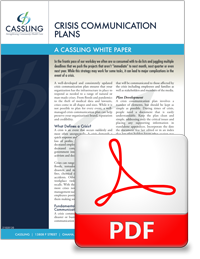Six Elements of a Crisis Communication Plan
by Cassling on Apr 7, 2020
Topics
white paper In the frantic pace of our workday we often are so consumed with to-do lists and juggling multiple deadlines that we push the projects that aren’t “immediate” to next month, next quarter or even next year. While this strategy may work for some tasks, it can lead to major complications in the event of a crisis.
In the frantic pace of our workday we often are so consumed with to-do lists and juggling multiple deadlines that we push the projects that aren’t “immediate” to next month, next quarter or even next year. While this strategy may work for some tasks, it can lead to major complications in the event of a crisis.
A well-developed and consistently updated crisis communication plan ensures that your organization has the infrastructure in place to respond as needed to a range of natural or man-made crises. From floods and pandemics to the theft of medical data and lawsuits, crises come in all shapes and sizes. While it is not possible to plan for every event, a well-managed crisis communication plan can help preserve your organization’s brand, reputation and credibility.
What Defines a Crisis?
A crisis is an event that occurs suddenly and most often unexpectedly. A crisis demands a quick response and, if mismanaged, can result in loss of profits, increased litigation, job loss, decreased employee morale, reputation damage, decreased competitive strength, increased government intervention, increased consumer activism and decreased trust in management.
Crises can range from natural disasters such as floods, tornadoes and blizzards to external disasters and medical emergencies including fires, chemical exposures and multiple victim accidents. Other examples of crises involve workplace violence, fraud and equipment recalls. With the introduction of social media, more crises now revolve around reputation management such as the case with two Dominos employees posting videos to YouTube showing them making some rather unsanitary pizzas.
Fundamentals of a Crisis Communication Plan
A crisis communication plan differs from a disaster or business continuity plan. A crisis communication plan considers the messages that will be communicated to those affected by the crisis including employees and families as well as stakeholders and members of the media.
Plan Development
A crisis communication plan involves a number of elements, but should be kept as simple as possible. During times of crisis, people need a document that is easily understandable. Keep the plan clean and simple, addressing only the critical issues and placing any supporting information in standalone appendices. Incorporate the date the document was last edited or in an index that lets plan holders know what section was updated and when.
Format the plan in a way that sections can be detached if needed. Prepare hard and soft copies of the plan and require crisis team members to keep a copy at their residence. During a crisis not everyone will have access to a computer and paper can be carried and copied. Keep additional copies on flash drives and CD-ROMS.
A crisis communication plan can be broken down into six elements:
The plan should outline and explain how your organization will communicate about the crisis and handle the crisis. Within the plan, include:
- Purpose of the plan: Explain why the plan is needed.
- Activation criteria: Identify who can activate the plan and under what circumstances.
- Procedures: Outline the steps that need to be taken in regard to internal and external communication, include who is responsible for what and what tools (e-mail, voicemail, intranet, news release, Twitter, etc.) will be used to carry out the plan.
The crisis communication team is responsible for collecting information, creating and disseminating key messages and working with the media. The team also monitors response to the crisis and crisis communication.
Within the plan, identify the members of the crisis communication team and describe their roles. Who will act as spokesperson and will there be more than one? Who will field media calls? Who will handle internal communication? Who will serve as back ups in each role? Include contact information for all team members including personal cell phone numbers.

3. Key messages
Consider all possible crises your organization could face and develop key messages to be used in response. Also consider what possible questions you could be asked by the media and draft responses to those. You may want to develop a vulnerability or grid assessment to help you determine how likely different types of crises are to occur at your organization or within your community.
While you may not use the messages verbatim, they can serve as a starting point and help you quickly pull statements together when needed. Your messages should:
- Identify the cause of the crisis
- Provide a brief description of what happened
- Provide a timetable for future plans
- Communicate compassion for any victims of the crisis
- Provide suggestions for protection if appropriate (i.e. remembering to wash your hands during a flu outbreak)
4. Internal communications procedures
Once a crisis occurs, determine how employees will receive key messages whether through department meetings, voicemail, the company intranet or all of the above. Consider how employees would be reached in a crisis if your building or internal communications were no longer available.
Employees also should be made aware of your organization’s media and social media policy and they should understand that they are not to talk to the media. Include a copy of these policies in the appendices of the plan.
5. Contacts and media list
During a crisis you will not have time to go searching for phone numbers. Gather contact information for local government offices, public health departments, evacuation centers, police and fire departments, Red Cross centers, suppliers and any other organizations you may need to communicate with during a crisis.
For the media list, include contact information for local, national and trade press as well as trade and influential industry bloggers.
6. Appendices
This section includes guidelines, checklists and forms that support and facilitate crisis communication. Appendices may include:
- First steps checklist
- Media policy
- Social media policy
- Media call log to document calls/communication received from members of the media
- Internal and external communication checklists
- Fact sheets
- Profiles and biographies for each key administrator
- Copies of organization logos/photos
- News release template
- Copies of the organization’s business continuity/disaster recovery plans
- Contact information for employees, crisis communication team members (including any outside legal or public relations representation) and the media
Web Site
Your Web site will be one of your most valuable tools in a crisis. Use it to provide timely, up-to-date information as well as other resources that will be of use to the public and the media. Doing so can significantly reduce the number of phone calls your organization receives and save you from having to repeat information multiple times.
You may want to create a dark or ghost Web site or page that can be made live when needed. This strategy allows you to funnel information in one place while keeping your main Web site in tact and helps ensure that you have as much information as possible ready to go when a crisis occurs.
Work with your organization’s IT department to ensure that the appropriate crisis communication team member or members can access and update the Web site from locations outside your building.
Media Training
Effective communication skills are paramount during times of crisis. Media training helps spokespeople learn how to interact with the media and the public in a stressful situation.
Identify and provide ongoing training to those people within your organization who may be responsible for speaking with the media in the event of a crisis. In addition to public relations/affairs staff, this list may include the organization’s president/CEO and other senior managers responsible for patient care, finance and operations.
Think carefully about who should be your organization’s spokesperson. A good spokesperson is someone who can make an effective connection with the audience. Remember, in certain crisis situations people’s lives may be impacted and with that, they need to hear from someone who can relate to them in a genuine and authentic manner. At the same time, the ideal spokesperson is someone who can speak clearly, deliver the facts, stay in control and stay on point.
Once you have determined your possible spokespeople, find a company that offers workshops or training to help these employees learn the best ways for effectively communicating with members of the media.
Social Media
Social networking has changed how we respond to a crisis. At times, social media is itself the source of the crisis as was the case with Dominos and Motrin’s mommy bloggers.
Within your plan you must consider how you will use social media to respond to crisis. Like it or not, a growing number of people look to these outlets in times of crisis or to hear what others are saying, or in some cases, not saying. According to PRNews, bloggers now outnumber traditional journalists by a ratio of more than 100 to 1, and social media sites like Twitter and YouTube have millions of active users and visitors.
Your organization already may be using social media channels like Twitter, Facebook and YouTube to communicate with customers. If so, you are one step ahead of the curve as you have a built in audience and have established goodwill. If not, these are outlets you may want to consider implementing now as a way to help monitor conversations and develop relationships with customers and the media.
As part of your crisis communication plan, someone in your department should be monitoring social media sites to find out what people are saying about your organization, employees and services. By simply listening to the conversation you can deter a potential crisis or, at the very least, engage a dissatisfied customer.
Employee Training
Employees should be made aware of the proper communication channels to report a possible crisis. Publish a notification procedure along with information on the roles and responsibilities of the crisis communication team on the organization’s intranet or in the employee handbook.
Execution
In a crisis, you have multiple audiences that need to be addressed including employees and the media and possibly family members, board members and government officials. Be sure to document as much you can during the process so you can come back later and determine what worked and what did not.
First, gather as much information you can about what has happened. What are the specifics? When did it happen and where? What is the extent of any injuries? What is certain and what is speculation?
Next, put the crisis communication plan into action. Contact the team members and begin updating key messages and other important information. Be sure to have messages cleared with legal and appropriate management before releasing.
Employees
Employee communication comes first in a crisis. Enact the internal communication procedures and get messages to employees as soon as possible, staying honest and giving them as much information as possible. If you cannot say something, tell them why not. Let them know that they will receive more information as it becomes available.
Remind employees of your organization’s media and social media policies. Be aware that although employees may not be talking to the media they may be talking about the crisis to family and friends. Once you have delivered the key messages, reiterate that only those messages should be communicated to anyone outside of the organization.
Media
Dealing with the media is one of the last things many people want to do in a crisis situation, but in reality the media is the gateway to your community at large. You may be inclined to answer “no comment” when the media comes calling, but doing so can increase the potential for the media to generate misinformation. Depending on the situation, it also can make your organization appear guilty.
Develop or revise your prepared statements based on what you know about the crisis. Consider all the channels you will use to get the message out including news releases, press conferences, Twitter and your organization’s Web site or blog.
When communicating with the media, stick to your key messages and above all, be truthful and do not promise what you cannot deliver. If you do not know something, say so and work to get the information out when it becomes available. Your first message should be short, accurate and outline positive action steps.
Determine how often you will update the media and make that information available on your Web site. Even If you do not have updates to provide, you must let people know. A “regular” news cycle no longer exists. People expect information to be continuous. Monitor news and information in all formats – print, broadcast and online – and respond when appropriate.
If the situation warrants you may need to set up a media or press center where the crisis communication team can work. This room should be set up in central location close to the crisis site and should be equipped with computers, phones, a podium and microphone, copy machines, office supplies, digital camera, printers, food and drink and anything else you can think of that the team will need, especially if they are going to be there for awhile.
Follow Up
Once the brunt of the crisis is over and you can return to normal operations, you should continue to monitor media coverage of the crisis, including social networks for any residual chatter.
Take the documentation you have kept and write up a brief report that outlines the cause of the crisis, how it was handled, successes and failures, and recommendations for change. Determine if any follow up needs to be done with media, employees, families or others and proceed in a timely manner.
Updates
Take what you have learned from the crisis and update the crisis communication plan accordingly. Regardless of whether or not a crisis occurs, the plan should be reviewed on a continual basis. Items such as employee and media contact information can change frequently and should be updated regularly, perhaps once a quarter.
// return //
Meet the Author
Cassling strengthens community healthcare through customer-centric imaging and therapeutic technology, services and solutions. From critical access hospitals and diagnostic imaging centers to large health systems and IDNs, Cassling is committed to helping healthcare organizations improve access and outcomes, create efficiencies and lower costs.





Comments